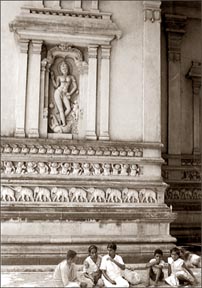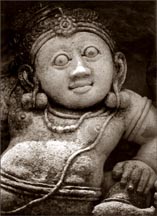Kelaniya's Grand Temple of Dwarves
 Sri Lanka is famous for its Buddhist art and architecture,
particularly the massive dagobas, or stupas, at Anuradhapura and the
images of Lord Buddha at the Gal Vihara in Polonnaruwa. Yet many
visitors don't realize that another impressive repository of Buddhist
art beckons just ten kilometres outside Colombo along the Kandy Road. Sri Lanka is famous for its Buddhist art and architecture,
particularly the massive dagobas, or stupas, at Anuradhapura and the
images of Lord Buddha at the Gal Vihara in Polonnaruwa. Yet many
visitors don't realize that another impressive repository of Buddhist
art beckons just ten kilometres outside Colombo along the Kandy Road.
The temple of Kelaniya is one of the most important places of worship
for Buddhists living in and around the capital. Believed to have been
visited by the Buddha himself, the temple has played an important role
in nurturing and spreading Theravada Buddhism throughout South Asia. It
not only provides a fascinating insight into Sinhala culture and history
but also features some delightful murals and carvings, including a
frieze of dwarves frozen in a range of enchanting gestures.
The exact date of Kelaniya's origin is unknown, but according to the
Mahavamsa the Buddha himself visited the site on two separate occasions.
Over the centuries, the fortunes of the temple have reflected those of
Lanka, the "shining land", with high points marked by artistic
excellence and such low points as times of colonial domination.
Though Kelaniya has been a place of worship for over 2,000 years, the
present temple buildings date mostly from between 1880 and 1940 base
days, the temple is surrounded by a small village of simple houses, but
it must have been a marvellous place to set eyes on in the 14th and 15th
centuries, when poets extolled the city's praises, as did Sri Rahula
thera in Salalihini Sandesaya: "Enter the great city of Kelaniya/Whose
beauty from moment to moment is ever renewed/Forests of bell-hung
banners enclose its fine dwellings/And glittering gems are set on its
pinnacle tips. (The inhabitants of the city seemed to be entranced by
its atmosphere).
 Amorous husbands and wives, each with no thought but for the other
/Wearing exquisite garlands of special fragrance/Their bodies anointed
with sandal paste and saffron/Lie in that city's moonlit balconies". Amorous husbands and wives, each with no thought but for the other
/Wearing exquisite garlands of special fragrance/Their bodies anointed
with sandal paste and saffron/Lie in that city's moonlit balconies".
It is worth approaching the temple slowly to take in all the details
on the way. It sits on a manmade hillock on a plain by the banks of the
Kelani Ganga. At the foot of the flight of steps facing the river are
guardstones, each with a bas-relief Naga king holding a flowerpot and a
twisted vine, as can be seen outside most Sri Lankan temples.
On either side of the king, in the lower corners, are two dwarves,
called yakka, who are spirit attendants of Kuvera, the god of wealth.
Like elephants, dwarves are believed to have great protective powers,
which is why the main temple is ringed with them.
At the top of the steps, standing beneath a stately triple archway,
the visitor faces the three great symbols of the "triple gem": on the
right is the dagoba, representing the living presence of Buddha; in the
centre is the main temple building, signifying the community of monks,
or Sangha; and finally on the left is a thriving bo (or pipal) tree,
which reminds us of the Buddha's enlightenment and as such symbolizes
his teaching.
Facing the dagoba is an encased statue of Vihara Maha Devi, presented
by monks of the Thai Sangha in 1990, and behind her is a small and
colourful devala, or shrine, dedicated to the god Vibheeshana, an ally
of Rama in the Ramayana epic.
The dagoba appears enormous to those who have not seen the massive
structures at Anuradhapura, which rival the pyramids of Egypt for sheer
size. The Kelaniya dagoba is said to contain, buried within its depths,
a gem-studded throne on which the Buddha sat on his second visit here.
It is certainly venerated by the local faithful who walk round it
piously, heads bowed and floral offerings clasped between palms.
The stupa is in the form of a paddy-heap, one of the earliest styles
found in Sri Lanka (other common shapes are bell and bubble), and
reaches a height of almost 30 metres. Seeming to take nourishment from
the offerings of devotees at its base, the majestic bo tree spreads its
boughs wide, offering shade for those who come to pay their respects.
The tree is surrounded by a golden railing and has a simple stone
Buddha image among its roots. Devotees bring lotus, water lilies and
fragipani to decorate the ledge around the tree's base, and the pungent
aroma of incense pervades the area.
 Flanked by these natural and man-made symbols, the main temple
building is an imposing structure that owes its existence to a couple of
Westerners, Henry Olcott and Helena Blavatsky, who came to the country
on a spiritual pilgrimage in 1880. Flanked by these natural and man-made symbols, the main temple
building is an imposing structure that owes its existence to a couple of
Westerners, Henry Olcott and Helena Blavatsky, who came to the country
on a spiritual pilgrimage in 1880.
Their fervour led to a resurgence of faith, and they managed to
secure donations sufficient for the reconstruction of the building,
which had fallen into disrepair. The delightful friezes and many of the
temple's best murals were added during this century by local artist
Soliyas Mendis, whose work has drawn comparisons with creations from the
golden age of Polonnaruwa in the 12th century.
The chubby dwarves endear the viewer instantly with their coy
expressions and unusual postures.
All of them play a part in seeming to support the temple wall, yet
none of them appears to suffer from the effort. No two of them are
alike; some stand on their hands, and some face inwards, while others
blow on flutes or strangely shaped horns.
Here and there plump fingers rest on rounded buttocks or a pudgy
stomach, giving a sense of innocent sensuality. There is the undoubted
influence of Indian classical art at work here, but the result is unique
- a wonder to behold.
The dwarves are set between other friezes of geese, representing the
distinction between good and evil, and elephants, the island's holiest
of creatures. The rest of the temple walls are decorated with sculptures
of humans, more dwarves and creatures that seem to be combinations of
various species. Beside the steps to the main entrance, the curled trunk
of a protective elephant has been worn down by the tapping of coins on
it for luck.
On entering the temple, the first sight is of a massive relief
carving of the Naga king Manihakkitha. The walls and ceilings of the
temple interior are covered with richly coloured and sharply detailed
murals recounting both the life of Lord Buddha and episodes in the
history of the temple.
One of Mendis' murals depicts the razing of Kelaniya by the
Portuguese - the first of three European powers to subject Sri Lanka to
colonial rule.
Not all of Kelaniya's bad times were caused by outsiders. Internal
intrigue and mistrust sometimes triggered disaster. One eye-catching
mural of a monk being dropped in a pot of boiling oil refers to an
incident when the monk, acting for the king's brother, delivered a love
letter to the queen, which was intercepted.
The outraged king was hardly any gentler on his wife, who was bound
and drowned in the Kelani Ganga. Other panels depict the Buddha's first
appearance at Kelaniya (in which Mendis captures wonderfully the
expressions of awe on the faces of shocked locals) and the arrival in
Sri Lanka of the Buddha's tooth hidden in the hair of a princess.
As does his sculpture, Mendis' painting shows influence from the
modern Bengal school, but the subjects seem to dance with a life of
their own.
A constant stream of devotees moves through the temple, dropping
handfuls of rice into an urn as symbolic offerings, lighting incense and
bringing newborns for blessing and initiation into the religion.
In contrast to the rich colours and movement on the walls of the rest
of the temple, the innermost shrine, called the Hall of Perfumes, is
backed by a painting of a blue sky with a single mountain peak.
A white gauze hangs between the small, golden, seated Buddha image
and visitors, who prostrate themselves and sit in silent prayer in the
temple's hushed interior.
The pious activities of its devotees, as much as the temple's fine
sculptures and paintings, make a visit here a special experience.
Worshippers come every day of the week; on a fullmoon, or poya, day,
it gets very crowded. The greatest crowds of all turn out for the
temple's annual perahera when people and elephants alike are dressed in
their finest for an unforgettable pageant.
Serendib
|
